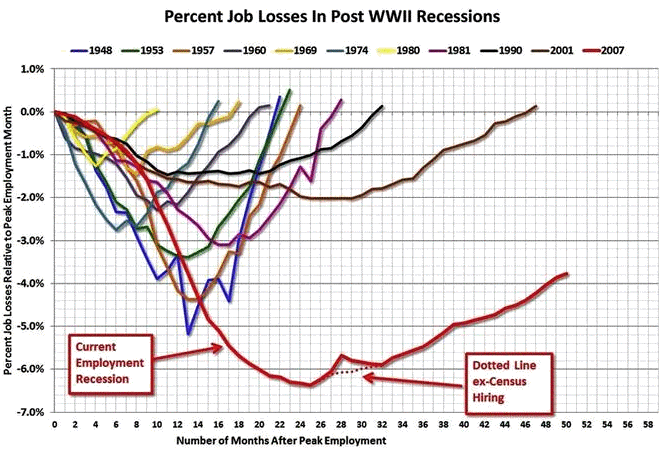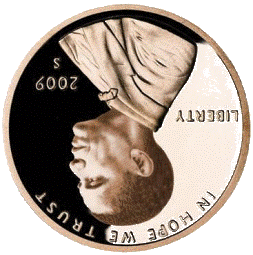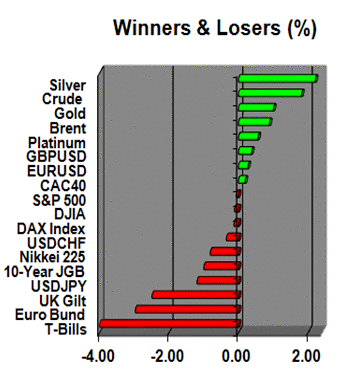 Friday’s jobs report was a huge miss and a big disappointment. The jobs report affect on the dollar collapse will be felt on Monday when markets worldwide feel the pain from the jobs report. The Japanese Yen has already gained nearly 1 percent against the U.S. Dollar. The Euro and the commodity currencies suffered the most by the jobs report while our neighbors to the north are leading the losses with the Canadian Dollar depreciating by 0.28 percent.
Friday’s jobs report was a huge miss and a big disappointment. The jobs report affect on the dollar collapse will be felt on Monday when markets worldwide feel the pain from the jobs report. The Japanese Yen has already gained nearly 1 percent against the U.S. Dollar. The Euro and the commodity currencies suffered the most by the jobs report while our neighbors to the north are leading the losses with the Canadian Dollar depreciating by 0.28 percent.
Where does this leave the U.S. economy? The March 13 Fed’s minutes indicated that officials are swaying away from a further easing since the U.S. economy has been showing signs of life. Federal Reserve Chairman Ben Bernanke noted during the meeting that additional stimulus could be warranted if the labor market continued to struggle. If the fed was to initiate another stimulus package, the dollar collapse will be imminent.
![]() Looking for Cheap Stocks? Subscribe and get our next penny stock picks FREE.
Looking for Cheap Stocks? Subscribe and get our next penny stock picks FREE.
Contrary to Bernanke’s comments, William Dudley, N.Y. Federal Reserve President, has made it clear that moderate job growth is to be expected considering the favorable weather conditions the U.S. has experienced during the past few months. The March Non-Farm Payrolls report came in at 120,000, well below expectations of 205,000. Private payrolls missed terribly, coming in at 121,000 versus expectations of 215,000. Even though unemployment fell to 8.2 percent from 8.3 percent., the economy only added 120,000 jobs after adding more than 200,000 each month since December. The rate dropped simply because less people are searching for jobs.
An interesting look inside the jobs reports reveals some very scary details:
Job loss in the construction industry, minus 7 thousand, most likely due to the weather. Construction is a weather-affected industry so it’s most likely a continuation of the reversal from December and January. Beyond that, you can’t blame the weather for the weakness in overall job creation in March. The most significant drop was the losses in retail for the second straight month: minus 29 thousand in February and minus 34 thousand in March.
Weather has nothing to do with retail jobs which are concentrated in general merchandise stores. According to the International Council of Shopping Centers (ICSC), comparable chain store sales showed solid growth in March, both on a year-on-year and month-on-month basis. It could be plausible that shifts in seasonal hiring are at play in the retail sales figures. Regardless, the puzzling job loss makes the March retail sales report to be released on Monday that much more important.
The Recovery vs. History:

The above chart shows the pace of the current jobs “recovery” vs. that of all other post-recession jobs recoveries. The dotted line is ex-Census hiring. This shows just how terrible the current employment recession is compared to any other post-war recession coupled with the length of time it has taken due to the lingering effects of the housing bust and economic crisis.
This recent jobs report was weaker payroll growth than expected (expected was 201,000). As you can see from the chart, the decline in jobs was much worse than any other recession by a long shot. Even though gainful employment has picked up in recent months, the turtle-like pace remains incredibly sub-par.
Is it too early to say that the jobs recovery is stalling?
It’s a Catch-22: Consumer spending comprises 70 percent of the U.S. economy. When employers won’t hire without enough sales, they cannot justify the additional hires. Without consumer spending, hiring is not worth their while. With an increase of just half a percent in February and only two-tenths of a percent in January, real spending hasn’t been going anywhere this year.
Consumers can’t spend what they don’t have which is helping the dollar collapse. Consumers aren’t spending more simply because they don’t have the money to spend. Income is increasing just barley enough to keep up with price inflation, two-tenths of a percent last month. The domino affect of that has hampered personal savings as a percentage of disposable income which is now at its lowest level since March 2009.
The American consumer is more concerned about cash preservation than spending furiously like they did in the 90’s . They are forced to save because their jobs are still insecure. There is no where to borrow from. Their home values are still not near what they paid for them. This is probably the most lopsided recovery in history with all the gains going to the one percent. There will be theories thrown out there about a hiring slowdown, but they don’t cut the mustard.
The dollar collapse is because of “uncertainty” about the economy. That’s bullshit – the economy’s future is always uncertain. It isn’t because of fears about an E.U. recession – Europe has been on skid row for awhile now. Besides, the U.S. economy doesn’t depends on exports to Europe anyway. It isn’t about gas prices or the rise in healthcare costs and insurance premiums – both have been trending up for nearly a year. It is simply because American consumers’ pockets are virtually empty.
 President Obama most likely will claim that the U.S. economy is improving, which, technically, it is. You will hear him state that growth this year average around two percent in tandem with inflation. Mitt Romney will claim the U.S. economy is in horrible shape and he will be able to twist the numbers to back it up and justify his “cup-half-empty” rhetoric.
President Obama most likely will claim that the U.S. economy is improving, which, technically, it is. You will hear him state that growth this year average around two percent in tandem with inflation. Mitt Romney will claim the U.S. economy is in horrible shape and he will be able to twist the numbers to back it up and justify his “cup-half-empty” rhetoric.
Romney is the perfect foil for Obama when it comes to placing blame on what went wrong because Romney represents the richest of the rich. Romney, a man who raked in over $20 million last year, paid a tax rate of just 13.9 percent. WTF? Yeah, 13.9 percent. Romney made his money by buying up “under-performing” companies that employed more people than necessary and carried less debt than was needed to show big profits. Romney’s firm, Bain Capital, made him and his colleagues fortunes by firing workers and loading companies up with debt.
Will the dollar collapse further with more easing?
It depends. Officials are obviously concerned with the lazy progress of the labor market and are most likely willing to extend efforts to foster growth. On the other hand, it’s pretty clear that a pullback in jobs growth was already anticipated which might mean that Federal Reserve officials hold stand their ground. Numerous policymakers are scheduled to speak next week. All ears will be Chairman Bernanke who will speak on two separate occasions, Bernanke’s comments are sure to drum up speculation that a third installment of quantitative easing is forthcoming.
The dollar collapse is already in affect on expectations that quantitative easing is back. The markets have been bullish in the absence of any real quantitative easing hype or propaganda. None of the squawking heads on CNBC, Bloomberg TV or FOX Business are screaming that the next round of easing is coming. They did it in the past and brainwashed many who get their investment advice from them that quantitative easing is required for the markets to rally.
It’s seems fairly obvious that the 2012 bull rally in the stock market has had nothing to do with a hope for another easing. The rally has been due to a steady stream of positive economic data. It has been a long time since improving fundamentals has been the driving force in the markets. The housing market has picked up ever so slightly, consumer confidence is growing and unemployment, statistically, is continuing to improve. The new jobs may be less than expected but the initial jobless claims came in at their lowest level in four years just one month ago.
As long as economic data trends in the right direction and the stock market averages maintain multi-year highs, it is idiotic to think that the Fed would decide to roll out another easing program. Dallas Federal Reserve President Richard Fischer said last week …
“There’s so much liquidity in the system… Why would we add more unless we had a crisis on our hand or something was happening where we’re seeing significant slippage in the economy?”
One thing is for certain: the improving economy has been excellent for penny stocks. The Russell 2000 is up about 9.63 percent in 2012. From up here, things look better than at any time since the economic crisis hit a few years ago. Most importantly, the pickup continues to bode well for penny stock investors. With all the liquidity that has been added to the financial systems, commodity prices are absolutely surging. With potentially another round of quantitative easing, fuel my be poured onto the fire.
 Inside the Numbers: The Jobs Report
Inside the Numbers: The Jobs Report
- U-6 underemployment fell from 14.9 percent to 14. percent.
- Average hourly earnings increased 2.1 percent.
From the report:
Nonfarm payroll employment rose by 120,000 in March, and the unemployment rate was little changed at 8.2 percent, the U.S. Bureau of Labor Statistics reported today. Employment rose in manufacturing, food services and drinking places, and health care, but was down in retail trade.
Household Survey Data
The number of unemployed persons (12.7 million) and the unemployment rate (8.2 percent) were both little changed in March.
Among the major worker groups, the unemployment rates for adult men (7.6 percent), adult women (7.4 percent), teenagers (25.0 percent), whites (7.3 percent), blacks (14.0 percent), and Hispanics (10.3 percent) showed little or no change in March. The jobless rate for Asians was 6.2 percent,
not seasonally adjusted.
The number of long-term unemployed (those jobless for 27 weeks and over) was essentially unchanged at 5.3 million in March. These individuals accounted for 42.5 percent of the unemployed. Since April 2010, the number of long-term unemployed has fallen by 1.4 million.
The civilian labor force participation rate (63.8 percent) and the employment-population ratio (58.5 percent) were little changed in March.
The number of persons employed part time for economic reasons (sometimes referred to as involuntary part-time workers) fell from 8.1 to 7.7 million over the month. These individuals were working part time because their hours had been cut back or because they were unable to find a full-time job.
In March, 2.4 million persons were marginally attached to the labor force, essentially unchanged from a year earlier. (The data are not seasonally adjusted.) These individuals were not in the labor force,
wanted and were available for work, and had looked for a job sometime in the prior 12 months. They were not counted as unemployed because they had not searched for work in the 4 weeks preceding the survey.
APR

